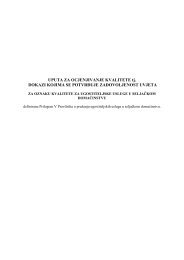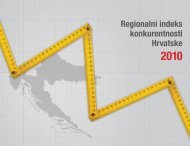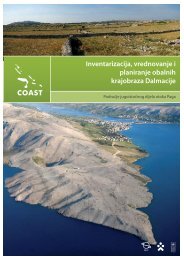WEB engleska verzija end.indd - UNDP Croatia
WEB engleska verzija end.indd - UNDP Croatia
WEB engleska verzija end.indd - UNDP Croatia
- No tags were found...
Create successful ePaper yourself
Turn your PDF publications into a flip-book with our unique Google optimized e-Paper software.
KEY CHALLENGESCHAPTER 4and Virovitica-Podravina, appearing four times andfour others appearing three times. Adding five moreindicators, as in Table 13, means that eight countiesappear in the bottom five four or more times, whiletwo new counties also appear in the list.In addition, while per capita GDP figures indicate aratio from highest to lowest of 3.12:1 in 2003 (WorldBank Background paper 4), the ratio of social exclusionis 16.29:1 (<strong>UNDP</strong>, 2006a), with six counties havingrates of above 20%. When aggregated into five compositeregions, the World Bank study still finds a considerabledifference between urban Zagreb’s povertyrate of less than 3% and a figure of over 20% in therural central region. The <strong>UNDP</strong> survey disaggregatedby counties shows high disparities in levels of trust, inestimates of quality of, and satisfaction with, educationservices, in Internet usage and in job security.Clearly, more research is needed to determine theunderlying causes of exclusion, not least of which isbecause the World Bank study can only account forsome of the regional discrepancies with what are normallythe key indicators of poverty, such as employmentstatus, age of household head, and householdsize. The observation, that “given the relatively largeunexplained regional differences in living standards,a regionally differentiated strategy probably makesgood sense for <strong>Croatia</strong>” (World Bank, 2006; 33), isparticularly welcome. Some elements of this typeof strategy have already been proposed under thedraft National Strategy for Regional Development incollaboration with the Ministry of the Sea, Tourism,Transport and Development. 184 The report pointsto large and widening socio-economic disparitiesbetween the counties, noting five, not necessarilymutually exclusive, areas with significant developmentneeds: the war-affected areas; traditional industrialareas; hilly and mountainous areas; the islands;and border areas. The report suggests a number ofremedial actions based on the premise that existingsupport to disadvantaged areas has been too smalland poorly co-ordinated.The Vision Statement of the Strategy includes pledgesto significantly reduce “the gap in internal income andliving standards between all counties, wider regionsand social groups across the country” by 2013. Whilemost of the focus is on broad-based capacity building,institutional strengthening, and multi-stakeholderpartnerships, the proposal to establish a Programmefor the Development of Disadvantaged Areas (PDDA)is of particular interest. It envisions an integratedGovernment plan for these areas (under the leadershipof the MSTTD), a unified definition of disadvantagedareas, to retain that status for seven years, andan integrated focus on economic and human capital,and infrastructure components. The designation ofspecific Action Zones, to promote social inclusion,access to health, education and employment will beneeded in the future to tackle the spatial dimensionsof exclusion in <strong>Croatia</strong>. In addition, a new ag<strong>end</strong>a totackle rural disadvantage on a much larger scale willbe needed. It is crucial for local social planning to beallied with redistributed transfer payments in order toavoid the more developed local provision of welfarebeing located in areas which need it least.Above all, a careful reconsideration of the causesand consequences of spatial inequalities is needed.These are multi-faceted and historical developmentalinequalities, including the specific effects of war andits aftermath, transition-induced restructuring, andthe current ‘gateway’ effect of EU candidate status.The importance of promoting labour mobility is afacet that has remained largely unquestioned butthat could lead to more young people leaving theircommunities to seek work in urban areas. This couldhave negative consequences in both smaller communities,with older, less skilled, or less mobile peoplebecoming more reliant on passive social assistance;and in the receiving areas, leading to discriminationin the housing market and new pressures of urbanisation.Simply promoting ‘mobility’ under-estimatesthe role of the ext<strong>end</strong>ed family as an effective andefficient form of social support. There is a need tostudy, much more closely, the disincentive effects inhibitinglabour mobility in <strong>Croatia</strong> and not to jump togeneral conclusions. To take just one example, thereis currently a shortage of qualified social workers inOsijek-Baranja county, and a surplus of unemployedqualified social workers in Zagreb. Reluctance tomove is, in large part, a result of the inability to secureadequate and affordable housing on the salary of asocial worker.141184 See web page: http://www.mmtpr.hr/UserDocsImages/CARDS_2002%20(D)/intro_en.html)

















